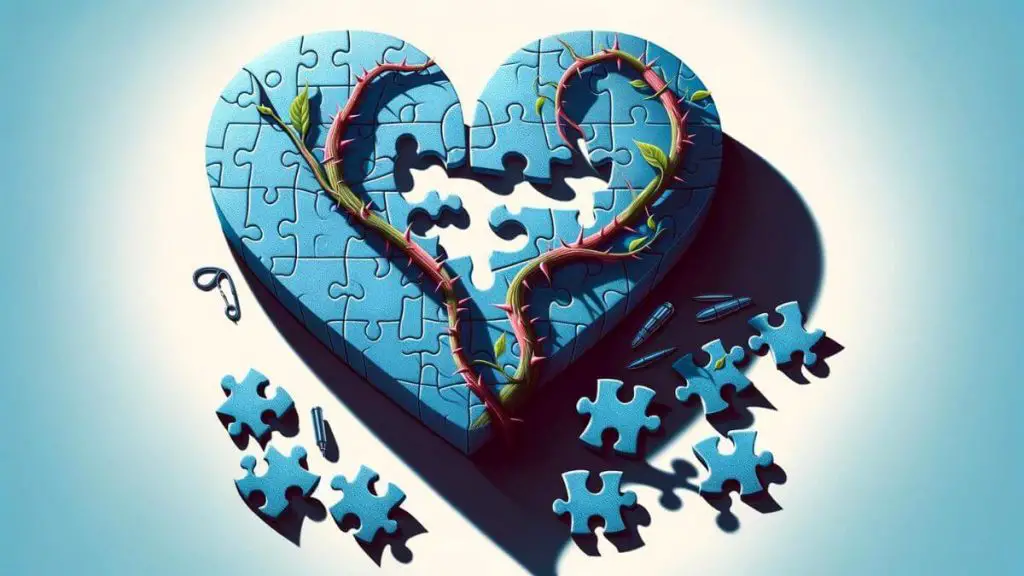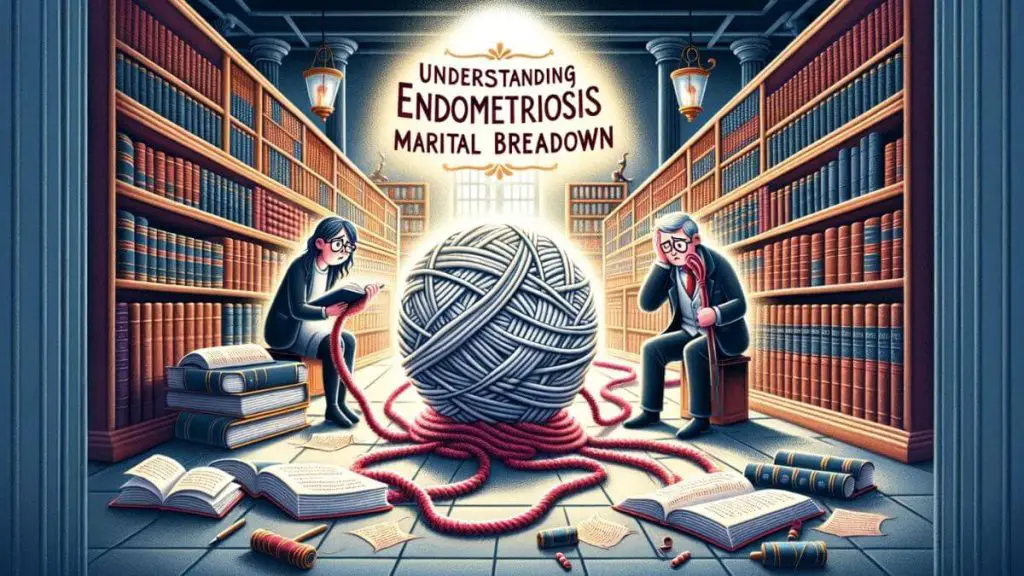Understanding Endometriosis Marital Breakdown
As a man deeply concerned for my wife’s well-being, understanding endometriosis marital breakdown has become an essential aspect of our journey. The impact of this condition on our relationship has prompted me to seek comprehensive insights into managing its challenges while nurturing our marriage.
Endometriosis marital breakdown refers to the strain placed on relationships due to the physical and emotional toll of endometriosis on both partners. It encompasses the difficulties in communication, intimacy, and support that can arise, requiring understanding, patience, and empathy to navigate effectively.
Scroll down to delve into practical strategies and empathetic perspectives on managing endometriosis within a marriage.
- Understanding Endometriosis Marital Breakdown
- The Impact on Male Partners
- The Strain on Relationships
- Coping with Chronic Illness in Marriage
- Seeking Marriage Counseling
- Impact on Sexual Function and Intimacy
- Planning for and Having Children
- Balancing Work and Household Responsibilities
- Emotional Support and Understanding
- Seeking Support Resources
- Building Stronger Relationships
- The Importance of Couple-Centered Approach in Treatment
- The Need for Increased Awareness and Support
- Conclusion on Understanding Endometriosis Marital Breakdown
- Source Links
Understanding Endometriosis Marital Breakdown
As the husband of a woman who suffers from endometriosis and fibromyalgia, I have witnessed firsthand the challenges and frustrations that come with these chronic conditions. It is a journey that often goes unnoticed, overshadowed by the focus on the physical and emotional pain experienced by my wife.
- But what about the impact on our marriage?
- What about the toll it takes on our relationship and our intimacy?
- What about our ability to navigate the ups and downs of life together?
Endometriosis, with its debilitating symptoms and unpredictable nature, can strain marriages to the breaking point. It affects not just the woman, but also her spouse, who becomes a silent witness to her suffering. The symptoms of endometriosis can be debilitating, causing severe pain, fatigue, and emotional distress. This can result in intimacy issues, communication breakdowns, and a feeling of helplessness for both partners.
So, what can we do to cope with the challenges of endometriosis in our marriage? How can we rebuild the intimacy that has been shattered by this condition? Is there a way to strengthen our bond and find a way forward, together?
In this article, I will share my personal insights and experiences as a husband navigating the complexities of endometriosis and fibromyalgia. We will explore the impact on male partners, the strain on relationships, coping mechanisms, the importance of seeking marriage counseling, and the need for increased support and awareness.
Whether you’re a husband, wife, or partner of someone with endometriosis, this article aims to provide guidance, understanding, and practical solutions to help you navigate the challenges and find hope in the face of adversity.
Join me on this journey as we shed light on the hidden struggles of being a husband in the realm of endometriosis and fibromyalgia. Together, we can break the silence, challenge common beliefs, and build stronger, more resilient marriages.

The Impact on Male Partners
Endometriosis significantly impacts men across various life domains. Men report that the condition affects their sex life, intimacy, ability to plan and have children, working lives, and household income. They also take on additional support tasks and roles to help their partners manage the challenges of endometriosis.
The emotional impact on men can include feelings of helplessness, frustration, worry, and anger. However, there is often a lack of recognition and support for male partners in endometriosis care, leading to their marginalized status. This underlines the need for healthcare practitioners to take a more couple-centered approach in the treatment of endometriosis, inclusive of partners and their specific needs.
The Strain on Relationships
Endometriosis can place significant strain on relationships. The chronic condition often leads to reduced sexual function and intimacy, as pain during or after sex is a common symptom.
Other factors that can affect sex and intimacy include bleeding during or after sex, fatigue, reduced sexual desire due to medication, low mood, stress related to fertility challenges, and loss of body confidence. Both partners may experience feelings of guilt, sadness, and loss associated with a lack of intimacy and affection.
Communication can also be difficult, as partners may have differing views on how endometriosis should be treated and managed. The emotional impact of endometriosis on both partners can lead to frustration, worry, and feelings of helplessness. It is crucial for couples to engage in open and effective communication, seek support through marriage counseling if necessary, and address the impact of endometriosis on their relationship and intimacy.
Communication Challenges
Endometriosis can create challenges in communication between partners. The differences in views on treatment and management can lead to misunderstandings and conflict. It is important for both partners to actively listen to each other’s concerns, share their own perspectives, and find common ground.
Seeking professional help through marriage counseling can provide a neutral and supportive environment for open communication and conflict resolution.
Impact on Intimacy
Endometriosis can significantly affect intimacy between partners. The physical symptoms and emotional impact can lead to a loss or decrease in sexual desire and function. It is important for couples to explore alternative forms of intimacy and find ways to connect emotionally and physically without triggering pain or discomfort.
Seeking guidance from healthcare professionals or therapists specialized in endometriosis and intimacy can help couples navigate these challenges and find solutions that work for both partners.
The Role of Marriage Counseling
Marriage counseling can be a valuable resource for couples facing the strain of endometriosis in their relationship. A trained therapist can provide support, guidance, and practical strategies for addressing the challenges posed by the condition.
Marriage counseling can help couples improve communication, manage conflict, and strengthen their emotional connection.
It can also provide a safe space for both partners to express their emotions and find validation and understanding.
| Communication Challenges | Impact on Intimacy | The Role of Marriage Counseling |
|---|---|---|
| – Differences in views on treatment and management – Misunderstandings and conflict | – Loss or decrease in sexual desire and function – Emotional impact on intimacy | – Support, guidance, and practical strategies – Improving communication and conflict resolution – Strengthening emotional connection – Safe space for expressing emotions |

Coping with Chronic Illness in Marriage
Coping with the challenges of endometriosis in marriage requires effective communication and mutual support. Partners should set aside specific time to talk about their worries, frustrations, and reflections, as well as the support they need from each other. It is essential to avoid expecting the partner to mind read and instead openly express feelings and needs.
Extension of kindness to oneself and the partner is crucial, acknowledging that endometriosis affects both partners differently.
Finding practical solutions to manage the impact of the condition, as well as addressing emotions and thoughts related to endometriosis, can be helpful. This may involve focusing on managing the condition rather than seeking a cure, allowing the expression of negative emotions, and finding a balance between optimism and acceptance.
Practical Strategies for Coping with Endometriosis in Marriage
- Open and honest communication: Creating a safe space for partners to express their feelings and needs can strengthen the relationship and improve coping.
- Support each other: Providing emotional support and understanding to each other’s experiences can foster connection and resilience.
- Seek professional help: Marriage counseling or therapy can provide guidance and tools for navigating the challenges of endometriosis in the relationship.
- Self-care: Taking care of one’s physical and emotional well-being is essential in managing the impact of a chronic illness like endometriosis.
- Flexible expectations: Adapting to the unpredictable nature of endometriosis and adjusting expectations can help reduce frustration and disappointment.
By implementing these strategies and fostering a supportive and understanding environment, couples can navigate the challenges of endometriosis and build a stronger, more resilient marriage.
| Benefits of Coping Strategies in MarriageImpact on the Relationship | |
|---|---|
| Improved communication | Enhanced understanding and emotional connection |
| Increased support | Reduced feelings of isolation and stress |
| Shared responsibility | Effective collaboration in managing the impact of endometriosis |
| Enhanced emotional well-being | Better mental health and overall relationship satisfaction |

Seeking Marriage Counseling
If difficulties in coping with endometriosis in marriage cannot be resolved through open communication and mutual support, seeking marriage counseling can be beneficial. Marriage counseling provides a safe space for couples to address the impact of endometriosis on their relationship and explore strategies for coping.
During marriage counseling sessions, therapists can help couples navigate the unique challenges that endometriosis brings to their lives. They can provide guidance on how to improve communication, develop effective coping mechanisms, and strengthen the emotional bond between partners.
Couples can also use marriage counseling as an opportunity to express their individual needs and concerns related to endometriosis. Therapists can provide guidance on how partners can best support each other throughout their journey with the condition.
Through counseling, couples can gain a deeper understanding of the impact of endometriosis on their relationship and learn valuable tools for managing the challenges they face. Seeking professional help can provide couples with the support they need to navigate the complexities of endometriosis and strengthen their bond.
By seeking marriage counseling, couples can find the guidance and support they need to navigate the challenges of endometriosis together, improving their relationship and overall well-being.
| Benefits of Marriage Counseling for Couples with Endometriosis |
|---|
| Provides a safe space for open communication |
| Allows couples to address the impact of endometriosis on their relationship |
| Guides couples in developing effective coping mechanisms |
| Improves communication and strengthens emotional connection |
| Helps partners better understand and support each other |
Impact on Sexual Function and Intimacy
Endometriosis can have a significant impact on sexual function and intimacy in a relationship. The pain during or after sex, known as dyspareunia, is a common symptom of endometriosis and can lead to a loss of intimacy. It is important for both partners to understand and empathize with the challenges of endometriosis-related pain.
Couples can explore alternative forms of intimacy and intimacy-building activities that do not involve triggering pain. Open communication about sexual desires, concerns, and boundaries is crucial for maintaining a healthy and fulfilling intimate life.
Seeking support from healthcare professionals and therapists who specialize in endometriosis can provide valuable guidance and strategies for managing intimacy issues in the context of the condition.

Planning for and Having Children
When it comes to planning for and having children, endometriosis can introduce additional challenges and anxieties for couples. Fertility problems associated with endometriosis can strain relationships and cause emotional distress.
Many couples affected by endometriosis find themselves faced with difficult decisions regarding their family-building options. They may require support from fertility specialists to navigate the complexities of conception with this condition.
It is crucial for partners to have open and honest discussions about their desires, expectations, and concerns related to having children. By addressing these topics together, couples can better understand each other’s perspectives and establish a supportive environment.
Seeking support from healthcare professionals, fertility experts, and support groups can provide valuable information and emotional support during the journey of trying to conceive with endometriosis. These resources can offer guidance, answer questions, and help alleviate the stress that couples may experience.
| Challenges and Considerations | Supportive Actions |
|---|---|
| Infertility linked to endometriosis can cause strain on relationships. | Seek support from fertility specialists and explore various family-building options. |
| Couples may face difficult decisions regarding their reproductive choices. | Have open and honest discussions about desires, expectations, and concerns related to having children, considering the unique challenges of endometriosis. |
| Emotional distress can arise from fertility difficulties. | Access emotional support resources such as therapy, support groups, or counseling to navigate the emotional impact of endometriosis on family-building. |
| Increased stress and anxiety during the journey of trying to conceive. | Lean on healthcare professionals, fertility experts, and support groups for guidance, information, and emotional support. |
Balancing Work and Household Responsibilities
When living with endometriosis, the impact on both partners extends beyond the emotional and physical aspects. The condition can also affect the working lives and household responsibilities of couples, presenting unique challenges that need to be managed.
Endometriosis may require the partner with the condition to take more time off work due to pain or medical appointments. This can create financial strain and feelings of guilt, as the burden of supporting both the household and the partner with endometriosis falls on the other partner. It is essential to acknowledge and address these challenges openly and honestly to find solutions that work for both partners.
One way to handle the impact of endometriosis on work and household responsibilities is through open communication. Discussing the challenges and setting realistic expectations can help alleviate stress and enable partners to support each other effectively.
Another crucial aspect is flexibility. Recognizing that the partner with endometriosis may have limitations and needs additional support can help create a more balanced and harmonious dynamic. It may involve renegotiating household tasks and responsibilities to ensure that both partners share the load equitably.
Support from family, friends, and support groups can also play a significant role in managing work and household responsibilities. Seeking practical assistance and emotional support from those who understand the challenges of endometriosis can provide much-needed help and relief.

Balancing Work and Household Responsibilities
Efficiently managing work and household responsibilities is crucial for couples navigating endometriosis. By finding a balance that works for both partners and seeking support when needed, couples can create a supportive environment that helps them cope with the challenges they face together.
| Challenges | Strategies |
|---|---|
| Partner taking more time off work | Open communication about work demands and seeking flexibility or adjustments from employers |
| Financial strain | Discussing financial responsibilities and seeking support from financial advisors or assistance programs |
| Renegotiating household tasks | Setting realistic expectations, communicating openly, and finding a balance in sharing household responsibilities |
| Emotional support | Seeking support from family, friends, or support groups to alleviate emotional strain and foster understanding |
Emotional Support and Understanding
Emotional support and understanding are crucial for partners living with endometriosis. Both partners may experience a wide range of emotions, including frustration, guilt, low mood, and irritability. It is important for couples to provide each other with emotional support and validate each other’s feelings.
Taking the time to listen, sympathize, and empathize with the challenges of living with endometriosis can strengthen the bond between partners. Sharing in the ups and downs, celebrating small victories, and providing reassurance can go a long way in helping each other cope with the daily struggles of the condition. It’s essential to prioritize open communication and create a safe space where both partners feel comfortable sharing their thoughts, concerns, and fears.
Seeking support from endometriosis support groups can provide a valuable source of understanding and a sense of community. Interacting with others who are going through similar experiences can validate the emotions and challenges faced by both partners. Support groups offer a platform for sharing advice, tips, and coping strategies, and can be an excellent avenue for gaining new perspectives and insights.
In some cases, couples may benefit from engaging in couple-oriented therapy. This can provide additional emotional support and a greater sense of understanding. A therapist can help couples navigate the unique challenges of living with endometriosis, facilitate effective communication, and provide strategies for coping together as a team.

Benefits of Emotional Support and Understanding
- Strengthening the emotional bond between partners
- Validating each other’s feelings, experiences, and challenges
- Providing reassurance and comfort during difficult times
- Sharing coping strategies and tips
- Accessing a support system through endometriosis support groups
- Improving communication and understanding between partners
- Seeking guidance and support through couple-oriented therapy
Comparison of Support Resources
Emotional support and understanding are essential for navigating the challenges of endometriosis as a couple. By providing this support, seeking resources such as endometriosis support groups, and exploring couple-oriented therapy, partners can strengthen their bond, cope more effectively, and face the challenges together. Remember, you’re not alone in this journey.
| Support Resources | Benefits | Considerations |
|---|---|---|
| Endometriosis Support Groups |
|
|
| Couple-Oriented Therapy |
|
|
Seeking Support Resources
When it comes to dealing with the challenges of endometriosis in a marriage, finding support resources specifically tailored for partners can be crucial. Often, partners of individuals with endometriosis feel isolated and struggle to connect with others who truly understand the unique challenges they face. Fortunately, there are various avenues for seeking support and finding a sense of community.
Online communities and support groups can provide valuable connections with individuals who share similar experiences. These platforms offer a safe space for partners to share their concerns, ask questions, and receive support from others who understand what they are going through. Engaging in discussions and reading about others’ experiences can help partners gain insights, validation, and a sense of belonging.
Additionally, couples can explore couple-oriented therapy or counseling as a means of addressing the impact of endometriosis on their relationship. These sessions provide a dedicated space for partners to work through their emotions, communicate effectively, and develop strategies for navigating the challenges they face as a couple.
Professional therapists can offer guidance, expert insight, and practical tools to strengthen the emotional bond between partners and foster a healthier relationship. By seeking support resources, partners can find solace in knowing that they are not alone in their journey.
Connecting with others who understand the unique challenges of endometriosis can provide much-needed validation, support, and encouragement. Whether through online communities or couple-oriented therapy, these resources can help partners cope with the impact of endometriosis and navigate the complexities of their relationship.

Building Stronger Relationships
Despite the challenges that endometriosis can bring to a relationship, it is possible to build stronger and more resilient partnerships.
Couples who face the difficulties of endometriosis together often develop a deeper understanding and appreciation for one another. Providing care and support can help partners develop a stronger bond and create a sense of unity. By acknowledging and addressing the impact of endometriosis on their relationship, couples can work together to find strategies for coping and maintaining a strong emotional connection.
Endometriosis can serve as an opportunity for growth and increased intimacy if couples approach it with empathy, open communication, and mutual support.
Strategies for Building Stronger Relationships
- Show empathy and understanding towards your partner’s experience with endometriosis
- Communicate openly about the challenges and emotions associated with the condition
- Provide practical and emotional support to one another
- Seek professional help, such as couples therapy or counseling, to navigate the impact of endometriosis on your relationship
- Explore alternative forms of intimacy that do not involve triggering pain
- Allocate dedicated time for bonding and connection
| Benefits of Building Stronger Relationships | How It Supports Coping with Endometriosis |
|---|---|
| Increased emotional support | Enhances overall well-being and reduces the sense of isolation |
| Improved communication | Helps address challenges and concerns effectively |
| Stronger bond and sense of unity | Provides a solid foundation for navigating the impact of endometriosis |
| Increase in mutual understanding and empathy | Fosters a supportive and nurturing environment |

The Importance of Couple-Centered Approach in Treatment
When it comes to managing endometriosis, healthcare practitioners play a vital role in supporting couples affected by this condition. Understanding the impact of endometriosis on both individuals in the relationship is crucial, which is why adopting a couple-centered approach in treatment is absolutely essential.
This approach addresses not only the physical aspects of endometriosis but also the emotional and relational aspects that can significantly affect a couple’s well-being.
By actively involving both partners in the treatment process, healthcare providers can create an environment that acknowledges and supports the unique challenges faced by couples dealing with endometriosis. This includes providing information and resources specifically tailored to the needs of partners, as well as considering relationship issues as part of the overall management plan.
A couple-centered approach recognizes that endometriosis impacts more than just the individual with the condition.
It recognizes the interplay between physical symptoms, emotional well-being, and the dynamics within the relationship. By taking a holistic view and considering the needs of both partners, healthcare practitioners can better support couples facing the challenges of endometriosis.
Benefits of a Couple-Centered Approach
Adopting a couple-centered approach in the treatment of endometriosis can yield several benefits:
- Improved communication: By involving both partners in the treatment process, a couple-centered approach encourages open and effective communication. This can help partners better understand each other’s perspectives and navigate the challenges together.
- Enhanced support: Recognizing the impact of endometriosis on both individuals in the relationship allows healthcare providers to provide tailored support and resources for partners. This can help partners feel validated and bring them closer together in their journey.
- Strengthened emotional connection: Addressing the emotional aspects of endometriosis within the context of the relationship can strengthen the emotional connection between partners. It allows them to support each other emotionally and foster a sense of understanding and empathy.
A couple-centered approach ensures that both partners receive the care and support they need throughout the journey with endometriosis. By recognizing and addressing the unique challenges faced by couples, healthcare providers can help improve the overall well-being of couples affected by this chronic condition.
| Benefits of a Couple-Centered Approach in Treatment |
|---|
| Improved communication |
| Enhanced support |
| Strengthened emotional connection |

The Need for Increased Awareness and Support
There is a pressing need for increased awareness and support for individuals with endometriosis and their partners. Currently, partners often feel marginalized and their experiences are overlooked in endometriosis care. This lack of recognition and support can contribute to feelings of isolation and strain on the relationship.
By increasing awareness and understanding of the impact of endometriosis on relationships, we can validate the experiences of partners and foster a more supportive environment. It is crucial to recognize that endometriosis not only affects the individual with the condition but also has a profound impact on their partner and the relationship as a whole.
Research on the divorce rate among couples affected by endometriosis highlights the need for targeted support and interventions to help couples navigate the unique challenges they face. Understanding the specific stressors and difficulties that endometriosis poses to relationships can guide us in providing the necessary resources and support.
To address these issues, we must strive to create a more inclusive and comprehensive approach to endometriosis care that acknowledges the importance of supporting both individuals with the condition and their partners. This can include educating healthcare professionals about the impact of endometriosis on relationships, providing specialized support services for partners, and offering relationship-focused counseling and therapy.
By acknowledging and addressing the impact of endometriosis on relationships, we can work towards providing the necessary support and resources to help couples cope effectively with the challenges posed by the condition. Together, we can create a more understanding and supportive environment where individuals and their partners feel seen, heard, and valued.
Conclusion on Understanding Endometriosis Marital Breakdown
The strain of endometriosis on marriages and relationships is significant, impacting various aspects of couples’ lives, such as sex, intimacy, fertility, and emotional well-being. However, couples can navigate these challenges and build stronger relationships through open communication, support, and understanding.
Healthcare practitioners have a critical role to play in addressing endometriosis’s impact on relationships by adopting a couple-centered approach in treatment. By providing resources and support for individuals with endometriosis and their partners, healthcare practitioners can help couples effectively cope with the condition.
Increased awareness and recognition of the impact of endometriosis on relationships are also necessary. As society becomes more informed about the challenges faced by couples, a more supportive environment can be created to assist those struggling with endometriosis and its effects on their marriages and relationships.


About Me
Hi, I’m Lucjan! The reason why I decided to create this blog was my beautiful wife, who experienced a lot of pain in life, but also the lack of information about endometriosis and fibromyalgia for men…
